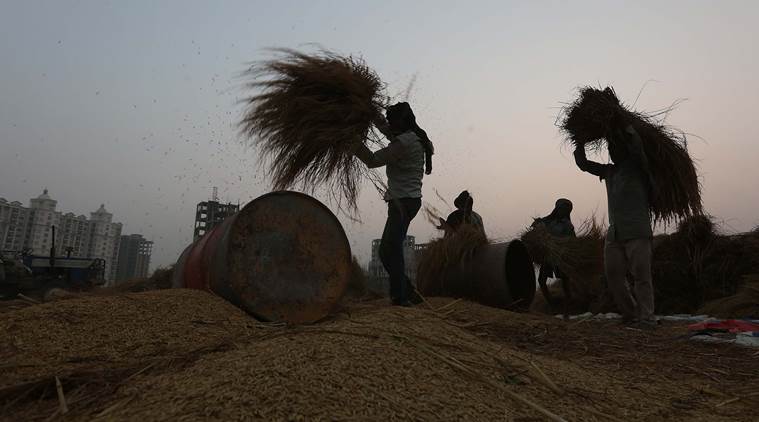- India
- International
Madhya Pradesh’s Basmati claim
The Narendra Modi government may find itself in a tricky situation over the issue of extending geographical indication (GI) certification for basmati paddy grown in Madhya Pradesh (MP).
 Currently, around 80,000 farmers are growing basmati on nearly 75,000 hectares in 13 districts. (Express Photo)
Currently, around 80,000 farmers are growing basmati on nearly 75,000 hectares in 13 districts. (Express Photo)
The Narendra Modi government may find itself in a tricky situation over the issue of extending geographical indication (GI) certification for basmati paddy grown in Madhya Pradesh (MP).
The Agricultural & Processed Food Products Export Development Authority (APEDA) and the Indian Council of Agricultural Research (ICAR) are both vociferously opposed to MP’s inclusion as a basmati-growing state.
The APEDA, which had originally filed the application to register “basmati” as a GI, has included only 77 districts in the Indo-Gangetic Plain along the foothills of the Himalayas — covering the states of Punjab, Haryana, Uttarakhand, Delhi, West Uttar Pradesh, Himachal Pradesh and Jammu & Kashmir — where this premium rice can be legally cultivation.
MP, which is scheduled to go to the polls later this year, has opposed APEDA’s application, while demanding that 13 of its districts — Morena, Bhind, Sheopur, Gwalior, Datia, Shivpuri, Guna, Vidisha, Raisen, Sehore, Hoshangabad, Narsinghpur and Jabalpur — also be given the GI tag. That would allow farmers there to continue cultivating this paddy and selling it as basmati.
Currently, there are around 80,000 farmers growing basmati on nearly 75,000 hectares in these 13 districts. MP’s estimated annual milled basmati rice production is about 3 lakh tonnes (lt), of which roughly 70% is exported and the balance sold within the country.

The above numbers are a fraction of the all-India basmati area of over 16 lakh hectares (lh): 7 lh in Haryana, six lh in Punjab, 2.6 lh in UP, 0.6 lh in J&K, 0.15 lh in Uttaranchal and 0.07 lh in HP. India’s total basmati rice output is roughly 60 lt, 40 lt of which is exported and valued at Rs 25,000 crore. The rest 20 lt is sold domestically and worth another Rs 10,000 crore. Half of this 20 lt comprises branded basmati rice and the remaining sold in loose form. The top brands include India Gate, Daawat, Fortune, Kohinoor, Patanjali and Lal Qilla.
“Politically speaking, it is difficult to ignore MP’s claim, more so with Assembly elections likely in November. Also, while 80,000 farmers may not be large compared to the two million growers in the main basmati states, they aren’t small either,” an industry source pointed out.
Besides, there is the commercial side. Many exporters — such as LT Foods, SSA International and Narmada Cereal Pvt. Ltd. — have established modern rice mills near Bhopal, sourcing the raw material at a relatively cheaper rate.
“In the 2017-18 season, Pusa Basmati-1 paddy prices in Punjab and Haryana mandis started at Rs 3,000 per quintal in late-October and rose to Rs 3,350 towards January. The average cost was roughly Rs 3,100. But in MP, prices ranged from Rs 2,600 to Rs 3,000, while averaging Rs 2,800 per quintal. The Rs 300/quintal difference translates into a cost advantage of Rs 4.5-5 per kg of rice (milled rice accounts for 64-65% of paddy grains),” noted a leading Delhi-based exporter.
Scientists at the ICAR’s Indian Agricultural Research Institute (IARI) are clear that the grain quality of basmati grown in MP — including the improved high-yielding and less photoperiod-sensitive “Pusa” varieties — cannot match that of the crop farmed in the Indo-Gangetic plains. Basmati rice’s most distinctive trait is its aroma, which derives from a compound called 2-Acetyl-1-Pyrroline. The accumulation of this highly volatile compound in the grain is largely a function of environmental conditions.
“The aroma retention is best when the plant’s flowering and grain-filling stages coincide with a cool climate, with temperatures below 30 degree Celsius during daytime and just over 20 degrees at night. You get these conditions from end-September through October only in the traditional basmati belt,” explained an IARI scientist, involved in the breeding of the blockbuster Pusa-1121 and Pusa-1509 basmati varieties.
Higher temperatures during the roughly one-month period from flowering to maturity can, moreover, impact the grain’s texture and milling quality. “When temperatures are high at the time of grain-filling, the packing of the starch granules in the rice tends to be loose. You, then, get grains with more chalkiness (opaque areas caused by incomplete filling) and leading to higher percentage of broken rice during milling,” added the scientist.
Scientific opinion may not, of course, matter as much in a case where politics and other interests also count. “This is a premium paddy that last season fetched Rs 2,800 per quintal, when the minimum support price for common non-basmati varieties was Rs 1,550. How can you deny farmers, especially in a less agriculturally-prosperous state, the opportunity to grow basmati?,” said the earlier-quoted industry source.
Therein lies the dilemma. The idea behind GI is to certify premium character to a product attributable to its geographical origin. APEDA’s GI application for basmati rested on its supposed uniqueness as a rice grown in a specific region of the Indo-Gangetic plain, “situated below the foothills of the Himalayas”. MP, according to it, did not fall within this specified geography, being situated far away from the Himalayan foothills
The GI Registry under the Office of the Controller General of Patents, Designs and Trade Marks, in an order dated March 15, rejected MP’s claim for inclusion as a basmati-growing state. The Shivraj Singh Chouhan-led BJP government in the state has filed a petition in the Madras High Court challenging the order.
“Today, we have a Rs 35,000-crore industry built primarily on the premium value of this rice. The danger is of it getting diluted, with more and more states staking claim for the GI tag,” warned the source.
Apr 16: Latest News
- 01
- 02
- 03
- 04
- 05






































